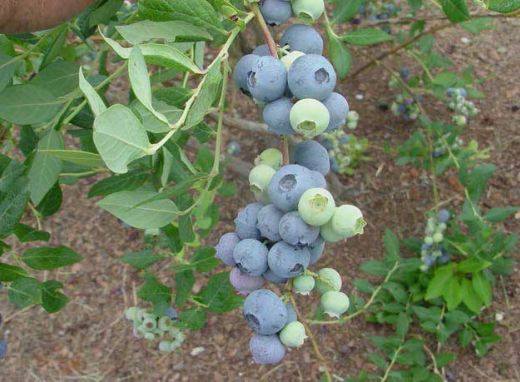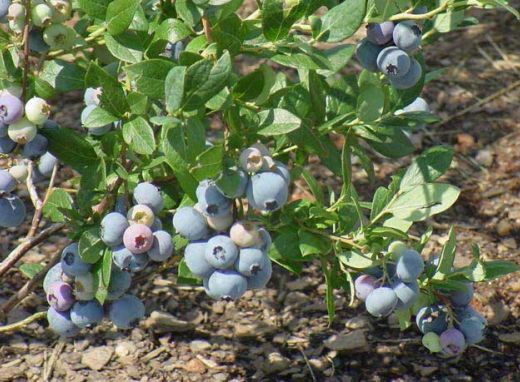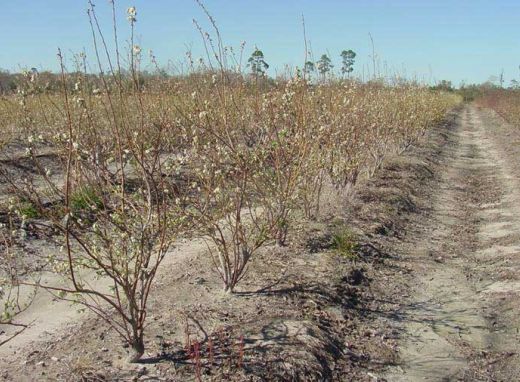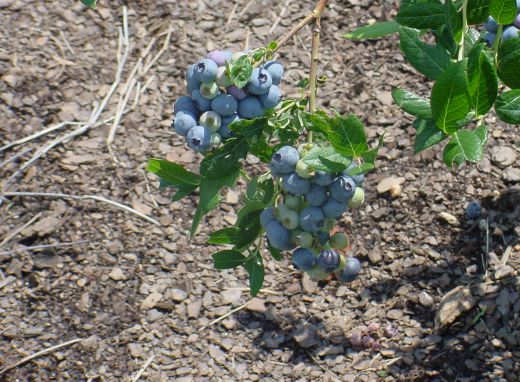At a Glance
Camellia is a mid-season southern highbush blueberry that has highly attractive berries, especially with regards to color and size. Plants are very vigorous with narrow crowns and strong, upright cane growth.
Commercial growers who want a high-quality, mid-season blueberry that takes them up to early rabbiteye ripening time should consider Camellia in areas where southern highbush are successfully grown. Camellia should also be a good choice of southern highbush for pick-your-own since flowering is a little later than most southern highbush varieties and the ripening period is somewhat extended.
Fruit
A large berry size and strong blue fruit color make this selection desirable for marketing. Berries are large (up to 2.5 g and greater), firm and flavorful.
Cultivation
One of the more outstanding characteristics of Camellia is its high degree of plant vigor as compared to many other southern highbush cultivars, both with and without pine bark mulch. The variety has proven to be adaptable across a wide range of growing conditions. Camellia flowers and ripens five to nine days after Star in south Georgia. Camellia requires 500 chill hours.
Care should be taken to not over fertilize Camellia, as it can grow excessively. Recommended companion variety for cross pollination is Suziblue for commercial growers and Palmetto for home gardens.
Testing
Tested as TH-621, the Camellia blueberry was selected in 1996 at the Coastal Plain Experiment Station in Tifton, Ga., from a cross of MS-122 X MS-6 made by the U.S. Department of Agriculture. Camellia has been tested in plantings at Alapaha, Ga., since 1998.
Development
Developed by D. Scott NeSmith of the University of Georgia, Camellia is a joint 2005 release by the University of Georgia College of Agricultural and Environmental Sciences, the University of Georgia Agricultural Experiment Stations and the U.S. Department of Agriculture/Agricultural Research Service. This protected blueberry variety can be sold only by individuals licensed by the University of Georgia Research Foundation (UGARF) and Georgia Seed Development (GSD). USPP 18,151.
Breeder

D. Scott NeSmith
Dr. D. Scott NeSmith’s blueberry research program at the University of Georgia emphasizes new variety development as well as cultural management of blueberries for the southeastern United States.
Since taking over the UGA blueberry breeding program in 1998, Dr. NeSmith has released and patented 10 new commercial blueberry varieties and two ornamental blueberry varieties. His breeding program is now considered one of the most active low- to-mid chill blueberry programs in the world. He joined UGA in 1990.
Dr. NeSmith has expanded UGA’s program globally through collaborative projects throughout the U.S. and many other countries including South Africa, Argentina, Chile, Uruguay, Japan, Europe, Morocco, Australia, New Zealand, South Korea, Peru, and Mexico. Much of his cultural management research has been with growth regulators in blueberries. He also conducts experiments on plant establishment, pollination, and post-harvest quality.
Dr. NeSmith is a member of the American Society for Horticultural Sciences (ASHS) and the International Society for Horticultural Sciences. He is a past President of the Southern Region ASHS and has served as an Associate Editor for the ASHS journal, HortScience.
Dr. NeSmith has received the D.W. Brooks Excellence in Research Award from UGA and in 2011 was selected as a Fellow of the American Society for Horticultural Sciences. He has published more than 250 research papers, including more than 97 in refereed journals, and has received two awards for outstanding publications.
He graduated from the University of Georgia with B.S. and M.S. degrees. He obtained his Ph.D. from Michigan State University.
Affiliations
- Department of Horticulture
- University of Georgia, Griffin Campus




